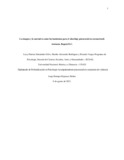| dc.contributor.advisor | Bejarano, Jorge Enrique | |
| dc.coverage.spatial | cead_-_josé_acevedo_y_gómez | |
| dc.creator | Vargas Garzón, Ricardo | |
| dc.creator | Hernández Silva, Lucy Patricia | |
| dc.creator | Rodríguez, Martha Alexandra | |
| dc.date.accessioned | 2021-08-30T21:39:37Z | |
| dc.date.available | 2021-08-30T21:39:37Z | |
| dc.date.created | 2021-08-08 | |
| dc.identifier.uri | https://repository.unad.edu.co/handle/10596/42279 | |
| dc.description.abstract | El conflicto armado interno que se ha vivido en Colombia por décadas se ha dado principalmente en el área rural y cuenta entre sus dinámicas la disputa por el territorio entre sus diferentes actores, esta disputa obliga en algunas regiones al desplazamiento forzado de poblaciones enteras, tal como se observa en el caso de desplazamiento forzado por parte del ejército colombiano a los pobladores de Peñas Coloradas en el Departamento del Caquetá. A través del relato de los sobrevivientes, se reconocen los impactos psicosociales por medio de las narrativas de sus propias vivencias y desde su lugar de enunciación como sobrevivientes se identifican subjetividades frente a imágenes dominantes de la violencia y su impacto. Mediante el diseño y uso de preguntas circulares se ayuda al sobreviviente a realizar conexiones de pensamientos, acciones y personas en diferentes momentos y eventos, a través de preguntas estratégicas que ayudan al relator a reconocer sus logros y resiliencia frente a la violencia sufrida y preguntas reflexivas que lo conducen a identificar sus habilidades, los recursos que ha logrado a través de su experiencia proyectándose hacia el futuro dejando atrás el miedo y buscando la oportunidad de ayudar a su comunidad. Igualmente, desde la narrativa de los sobrevivientes se hace posible la transformación de experiencias estresantes en historias esperanzadoras donde surja un posicionamiento resiliente frente a las imágenes de la violencia mostrando así que la forma de decir es importante en la elaboración de los sentimientos experimentados. Desde la técnica de foto voz es posible abordar con los sobrevivientes lo colectivo y la conciencia histórica que se enmarca en las fotografías y su procedencia desde diferentes contextos estableciendo un equilibrio entre lo cotidiano con la historia y con la violencia vivida a través de la estética y la narrativa permitiendo cuestionar y replantear sus realidades como acto sensible que permite resignificar el territorio humanizándolo. Así, las estrategias de intervención evidencian su importancia cuando la misma población lidera acciones que lo convierten en sobreviviente alejándose del lugar de víctima y abandonando la naturalización del sufrimiento evitable que representa el desplazamiento forzado del que ha sido víctima. | |
| dc.format | pdf | |
| dc.title | La imagen y la narrativa como herramientas para el abordaje psicosocial en escenarios de violencia. Bogotá D.C | |
| dc.type | Diplomado de profundización para grado | |
| dc.subject.keywords | Conflicto armado | |
| dc.subject.keywords | Desplazamiento | |
| dc.subject.keywords | Narrativa | |
| dc.subject.keywords | Resiliencia | |
| dc.subject.keywords | Sobreviviente | |
| dc.description.abstractenglish | The internal armed conflict that has been experienced in Colombia for decades has occurred mainly in rural areas and has among its dynamics the dispute over territory between its different actors, this dispute forces in some regions the forced displacement of entire populations, such as It is observed in the case of forced displacement by the Colombian army to the inhabitants of Peñas Coloradas in the Department of Caquetá. Through the stories of the survivors, the psychosocial impacts are recognized through the narratives of their own experiences and from their place of enunciation as survivors, subjectivities are identified in front of dominant images of violence and its impact. Through the design and use of circular questions, the survivor is helped to make connections of thoughts, actions and people at different times and events, through strategic questions that help the rapporteur to recognize their achievements and resilience in the face of the violence suffered and reflective questions that lead him to identify his skills, the resources he has achieved through his experience, projecting himself into the future, leaving fear behind and looking for the opportunity to help his community. Likewise, from the narrative of the survivors, it is possible to transform stressful experiences into hopeful stories where a resilient position emerges in the face of images of violence, thus showing that the way of saying is important in the elaboration of the feelings experienced. From the photo-voice technique, it is possible to approach with the survivors the collective and historical consciousness that is framed in the photographs and their origin from different contexts, establishing a balance between the everyday with history and with the violence experienced through aesthetics and the narrative allowing to question and rethink its realities as a sensitive act that allows redefining the territory by humanizing it. Thus, intervention strategies show their importance when the same population leads actions that make them a survivor by moving away from the place of victim. and abandoning the naturalization of the avoidable suffering represented by the forced displacement of which they have been a victim. | |
| dc.subject.category | Psicología | |















